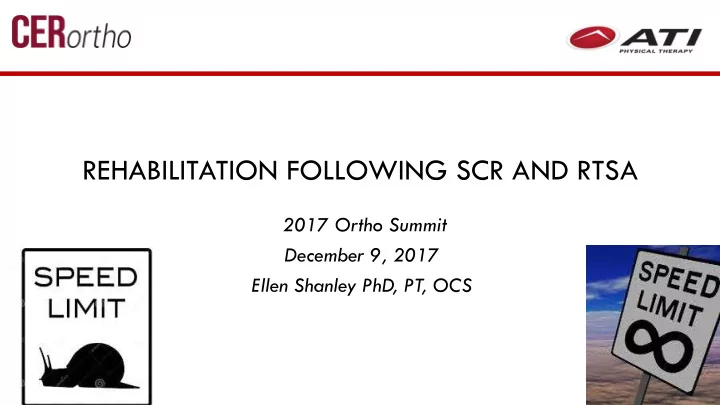

REHABILITATION FOLLOWING SCR AND RTSA 2017 Ortho Summit December 9, 2017 Ellen Shanley PhD, PT, OCS
I (and/or my co-authors) have nothing to disclose. Detailed disclosure information is available through the Orthopedic Summit
The Paradigm PROCEDURE PROBLEM TREATMENT IMPAIRMENT GOALS PATHOLOGY
rTSA compared to SCR
Influence on Choice & Progression Cuff Deficient ⇣ Function Shoulder Pseudo Pain Paralysis
Our Responsibility… Managing Expectations Appropriate For Each Patient
Implications for Rehabilitation Young ⇡ Age GOALS IMPAIRMENT Function vs Pain PATHOLOGY Massive RCT
Intra operative findings- rTSA Type of implant/component Humeral bone quality, Deltoid status Integrity of remaining RC, Concomitant RC repair Overall component stability.
Common complications RTSA Scapular notching Component Failure/ disassociation Dislocation Infection Acromial Stress fracture
Key Concepts- rTSA 3 Key Rehab Concepts: 1. Joint protection 2. Deltoid function a. Remainder of RTC 3. Est appropriate functional goals a. ROM
Priorities AROM & ant ROM- 90º FE; Adv strength deltoid Strength 20º-ER Limit cycles No body wgt Submax Iso’s protect stability Limit cycles of & Limit stress Scapular Ex ROM Hold vs. cycles….
rTSA rTSA higher risk for dislocation vs. conventional TSA (Boudreau et al., 2007) Dislocation typically occurs in IR, adduction and extension (reaching behind back)
Early expectations 3-4 weeks….
DC Outcomes
Implications for Rehabilitation Young ⇡ Age GOALS IMPAIRMENT Function vs Pain PATHOLOGY Massive RCT
SCR Implications for Rehab Allograft Best tissue @ day 1 post-op “soft tissue rTSA ” (Thay Lee, PhD) Augmented massive RCR Rotational stress Tenodesis effect of subscapularis & infraspinatus Long axis stress Gravity ”distraction” (Mihata et al AJSM ’16)
Intra-operative Findings- Expectations Restoration of PROM Amt Subscap/ Infra Remaining Tissue Mobilization Position AROM- Amount of native tissue
SCR Treatment Pathway Massive RCR Pathway Failure of Massive RCR- 98% in 1 st 6 months Repairs of tears > 4cm fail < 12 wks ( Miller et al AJSM ‘11) ☐ Increased risk of “re-tear/non healing” with early AROM ☐ < 3cm early 1.63x ☐ > 3m early 2.5x ☐ > 5cm 6x
Priorities Education Protect Joint 5 weeks- healing tissue Protection distal UE & Protection ROM only Care Functional Box ER then FE- Mobility ROM ADL’s
Protected ROM Rehabilitation plan to match the surgery and the patient Graft type • Other cuff status • Patient goals/context •
Goals • Work • Sport Loading • Position • Reps Demands
Controlled Loading for Function >50% 40-60% 25-50% • All suggested exercises < 40% rotator cuff EMG
Great < 90 then Fight Gravity Restore Force Couple
Patient Outcome Expectation n=9 n=8
AROM Return After SCR
The real story on AROM return n= 22 n=12
Return to Function ➔ No heavy lifting 4-6 months ➔ Sport progressions o Golf > 20 weeks o Tennis >26 weeks o Swimming >26 weeks (Fealy S et al. ’02; McKee MD et al. 00; Ellman et al ‘86; Charousset et al ‘08)
Healing Time to Function
Recommend
More recommend